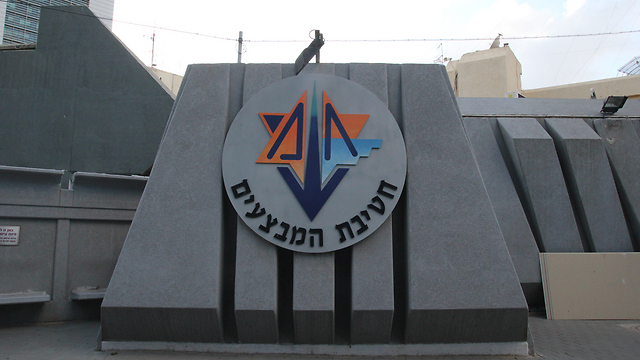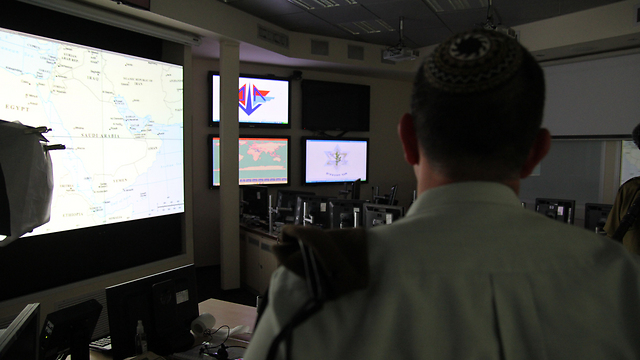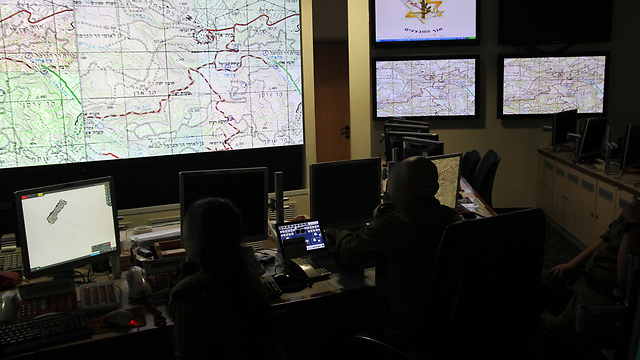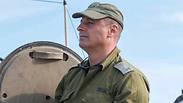
Inside ‘the pit’: Commander offers rare peek into IDF nerve center
From his underground office in Tel Aviv’s Kirya Base, Brig.-Gen. Turgeman oversees hundreds of secret military activities a year as head of IDF's Operations Division. In a special interview, he explains why Hamas isn’t interested in a conflict with Israel, says Israel’s biggest threat is in the North and reveals that the IDF helped thwart a terror attack against Russian forces in Syria.
The interview with Brig. Gen. Turgeman, head of the Operations Division, offers an extremely rare peek into his classified and unusual workspace. It’s an underground maze of corridors, operations rooms, offices and conference rooms, including the chief of staff’s emergency bureau.
“I call it the beehive,” he says. “Serving in the operations center in the pit isn’t really like serving in the Kirya. It means working 24/7 during routine times and during emergencies. The entire operational activity takes place here. We plan all the programs, synchronize all the bodies, and in the end, it’s issued as an order. Hundreds of people man the place, a very committed and strong reserve system, functionaries who have been with us for many years. The quality of the people here is uncompromising. Many of the officers are women, mothers. Such an officer can leave at 4 pm, pick up her kids, give them dinner and come back here till 1 am.”

Some of the officers pass through the Operations Division as part of their operational promotion path—after a regiment commander position, before a brigade commander position. Others have been serving in the pit for a long time, sometimes more than a decade, and are known as the “knowledge hub.” They usually have a rich operational background as well.
“I always thought I knew the army,” says one of the officers, who served as a regiment commander in the past, “but only when I came here I realized I hardly knew anything.” This comment is repeated by nearly every officer you talk to in the pit. They know so much, but are allowed to reveal so little. “A young operations sergeant goes home after a shift at the IDF’s nerve center, and all she can tell her friends and family is that she serves in the Kirya,” explains a head of one of the IDF branches.
“The service here is very demanding,” says Turgeman, “and many people are afraid to come here because of the hours and the urgent calls. But those who come don’t want to leave. We’re a small operational family. The complete disconnection from the outside world isn’t easy either. The only window I have here is the picture on the wall. No one, not even my wife, can get hold of me on the phone here.”
What’s it like not being available in the technological era?
“I do have Internet access, but I don’t have time. It’s a matter of time. We’re based on a very strict and very hierarchical report axis here. When something happens, we sometimes hear about it from the media before receiving the operational report, and then the check system begins. There’s competition over the report, which did not exist in the past. My rule is that we take a small breath, try to obtain more details, and sometimes get held up because we have to provide a credible report. I’ve already seen reports on incidents which never happened, getting as far as the prime minister.
“The reports launch a series of actions here. The Halamish incident, for example. You know that there’s been a terror attack and there’s a report about a terrorist in a community. I don’t ask questions. I immediately launch Heavenly Host (the codename for a terrorist incident involving hostages). I take the most complex scenario available for such an event, and we dispatch planes, helicopters and special units.”
The IDF’s most senior brigadier-general
Brig. Gen. Turgeman, 48, “owes” his appointment as head of the IDF’s Operations Division to Colonel (res.) Ofek Buchris. In March 2016, a day before Buchris—who still held the rank of brigadier-general at the time—was supposed to take office, it was revealed that one of his former soldiers had filed a sexual assault complaint against him. The inauguration ceremony was called off, and IDF Chief of Staff Gadi Eisenkot was forced to quickly find a suitable replacement for the most senior brigade-general post in the army, who basically serves as the chief of staff’s operations officer.
At the time, Turgeman was in his office in the Kirya Base as head of the Ground Forces, a job that gave him a bit of a rest from his previous demanding position as commander of the IDF’s 36th Armor Division, which fought in Operation Protective Edge.
“The first phone call I got, as soon as the Buchris affair was made public, was from my wife,” Brig. Gen. Turgeman recalls. “She said to me, ‘Pack up your office stuff, you’re about to become head of the Operations Division.’ I replied, ‘Come on, it’s a key position.’ But 10 minutes later, I got a phone call from the major-general, the head of the GOC Army Headquarters, who informed me: ‘The chief of staff is calling you.’”
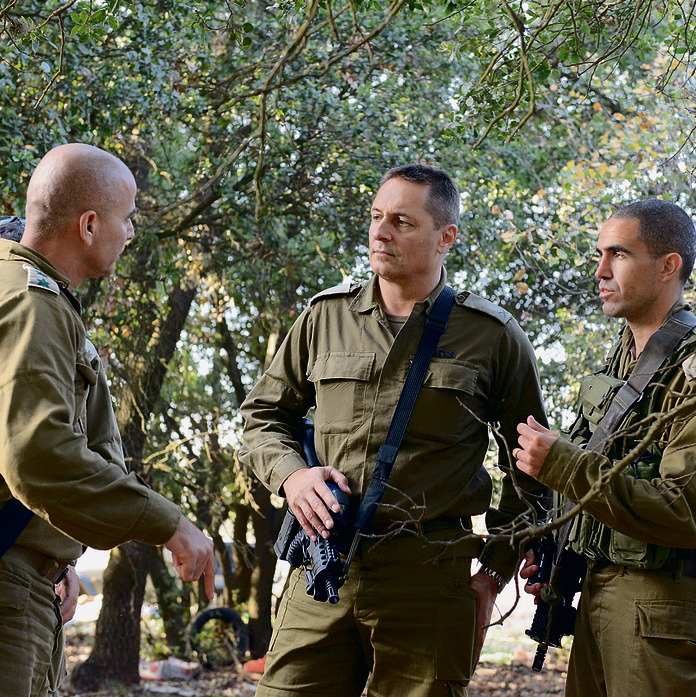
The Kirya pit, where all sensitive military campaigns and operations are run from, wasn’t new to Turgeman. In one of his previous positions, as colonel, he served as head of the operations platoon in the pit, who is in charge of the supreme command post, the IDF’s main operations room, and manages it at times of war. Now he returns to the pit as head of the Operations Division. In the upcoming round of appointments, he is expected to compete for the position of a major-general.
“There are very few officers who have led both a platoon and a division,” he says. “Eli Yaffe, Gabi Ashkenazi, Kobi Barak. Quite a few people would say it’s insane. Returning to such a senior position in the pit is a significant event. On the one hand, it’s not a position you have to learn, because you know what you’re getting into. An operations platoon commander is well familiar with the pit. On the other hand, it’s such a burden, it’s so complex and there are so many nuisances. But I’ve been here for nearly a year and a half, and it’s really a lot of fun.”
Do you see any changes in the pit since your time as platoon commander?
“I think the situation today is completely different. The chief of staff ascribes a lot of importance to the Operations Directorate. He sees the head of the Operations Directorate (Major-General Nitzan Alon) as the army’s No. 3 and us, the Operations Directorate, as the operator. We really are the chief of staff’s operational headquarters.
“It’s true there’s the Air Force, the Navy and the Military Intelligence Directorate, and they’re all operational forces, but at the end of the day, when you look at the General Staff, at what has really changed and at what is being emphasized, you see we’re no longer dealing with niches. Every area or every command are a niche, and we operate between the political echelon and the tactics. We are the mediators. The political echelon issues missions or instructions and we translate them into orders. We are in many areas. There are no boundaries. Almost everything flows in here. The operational axis reaches the chief of staff exclusively through the Operations Directorate, unlike in the past, when it would reach him from other sources.
“We are the only ones who see the entire system of constrains and meanings. The Central Command chief is only interested in the Central Command, only in the Palestinian arena, mainly in the Judea and Samaria Division, and rightfully so. The Southern Command chief is interested in the Gaza arena and in a bit of Sinai. We look at the meaning, at the list of priorities, at our ability to achieve things. We ask where is it important for the chief of staff to operate now, where is the big threat.”
And what are the estimates regarding the threats?
“In terms of strength, the main threat is from Lebanon, the northern arena. But the threat with the highest likelihood is actually from Gaza. It’s what guides us in terms of our preparedness. At the moment we’re not seeing an outburst in the northern arena, but when it happens, it will be the worst threat the State of Israel could face in terms of strength.”
And Gaza?
“At the end of the day, there is a security calm in Gaza. People look at every rocket, at every bullet that is fired here, but over time there is a relative calm, and I believe it’s mainly the result of fear. We have no enemy here today who is interested in a conflict with us. This has been proven. There is no one who wants a conflict. We can get dragged into a conflict out of the unwillingness on both sides. That’s how we got dragged into Protective Edge, that’s how we got dragged into Cast Lead, that’s how we got dragged into Pillar of Defense.
“It can start from something that depends on neither side. If we take the Gaza Strip, we have the Salafists who fire to make us target Hamas. If we hit them deep enough and Hamas decides to launch a new round, we didn’t want it, no one wanted it, yet we got dragged into it. There’s an escalation dynamic here, and we’re trying to be the responsible adult here and control this dynamic.”
The prince from the Armored Corps
He is married, has three children—the oldest one is a fighter in the Paratroopers Brigade—and he is well familiar with the fighting on the ground. He joined the Armored Corps in 1987, spent some time in the 500th Brigade until it was dissolved, served as commander of the 46th Battalion in the 401st Brigade, where he received the nickname “prince” and was already seen as having a bright future. He later served as the brigade commander when it received the first Merkava Mark IV tanks. He then moved on to his first position in the pit as head of the operations platoon, before being appointed head of the Personnel Division in the GOC Army Headquarters. Just four months later, Defense Minister Ehud Barak made him his military secretary, despite then-Chief of Staff Gabi Ashkenazi’s objection. He later assumed command of the prestigious 36th Division, which soon after his appointment found itself in the Gaza Strip, as part of Operation Protective Edge.
In hindsight, would you say we won in Operation Protective Edge?
“I think the calm speaks for itself. If anyone waited for it to be like in the canal and in the posts, for them to raise white flags, I think they’re wrong and fail to understand the war in the modern era. The veteran people I was raised on said to me: ‘We crossed the canal, we traveled 60-70 kilometers in Sinai.’ But what did you encounter? What did you go through? They’re talking about an Egyptian army they were prepared for. Today we are dealing with a very complex constructed area, with a population that cannot be evacuated anywhere, and with a huge underground space.
“When I entered Protective Edge, the commander of the Golani patrol unit said to me 42 minutes later: ‘I’ve reached the end of the arrow.’ And that’s where the casualties began. Because what we crossed and went through was the entire ground area, and then the underground began leaving its mark. They came out of one place, they came out of another place. We began demolishing buildings, leveling holes, bombing missiles. In the first entry we almost ran into (the Gaza neighborhood of) Tel al-Hawa in the southwest part of the strip, and (then-Chief of Staff) Benny Gantz yelled at me: ‘Go back immediately.’”
Do you think Hamas has been deterred since then?
“I’m certain. There’s a sequence of events which happened in the past year, strikes carried out by the IDF in the strip in response to mortar shells fired into Israel. It’s something they wouldn’t have ignored in the past, but the fact is that things are quiet. Moreover, following every local incident Hamas goes out and acts against the rebels. Hamas understands that Israel will act aggressively.”
Unlike top IDF generals, including the chief of staff and the military intelligence chief, Turgeman’s great fear is the moment Hamas internalizes the meaning of the new underground obstacle being built on the Gaza border. The senior generals believe Hamas is sufficiently deterred to contain the obstacle’s construction. Turgeman disagrees.
“We plan to build the entire the strip, and the more they realize what is happening, the more they’ll try to disrupt it,” he says. “They are realizing that that’s it, we’re shutting off the strip, and this time hermetically, from the bottom.”
You believe they’re starting to understand that?
“I can see that they’re surprised by the scope. At first, we built opposite the community spaces. We wanted to close the spaces linked to the communities. Now they see we’re planning to close the seam, and they’re beginning to realize that this is going to shut off the entire strip.”
Will this obstacle remove the threat?
“It will significantly reduce it. Hamas has realized that we have the Iron Dome system, and I think that as soon as we harm its tunneling project it will be much more deterred, and that will postpone the next battle significantly. After the obstacle is built, Hamas will need a very clear interest to launch a battle. So I keep thinking that at some stage it will wake up, although it may be too late already, but I’m not sure.
“If Hamas starts firing now and hits one of our workers, who will come to work? Arabs? We put up a battery to protect the people, we boosted the security forces. But an incident that includes a Hamas raid and the abduction of a soldier or of one of our workers is a significant disruption. It will lead to an operation or a round of fighting. That’s not what we want. The political echelon’s instruction was: ‘We want the obstacle to be completed by 2019.’ That requires maturity, restraint and containment in some of the places which call for a significant response, because we don’t always know how to sit down and be quiet.”
In Operation Protective Edge, he isn’t afraid to admit, “we weren’t deep in the underground world. We were familiar with the threat, but not with its scope. Today we know much more. Today we are also operationally and mentally prepared in a different way.”
The Golani, 188th and 7th brigades were under his command during that operation, as were the company commanders’ school and the division’s artillery support unit. The battle he commanded, the most memorable one of that war, was the Golani Brigade’s battle in Sajaiyeh, which began on July 20, 2014 and left 13 fighters killed. The body of one of them, Oron Shaul, was kidnapped. In the same battle, Golani fighters entered Sajaiyeh in an outdated armored personnel carrier which was hit by an explosive charge and by a Hamas missile. This later led to a public debate on why the fighters were sent in on such an old APC instead of walking the 2-kilometer distance by foot.
“I don’t regret the decision to send the force in on APCs,” Turgeman says today. “It was the main fighting vehicle, and what could we do? We didn’t have enough armored APC. The Golani force stationed on the fence was hit with 75 mortar shells, and my dilemma in light of the threat was whether to put them in the unprotected vehicles we had, or to send them by foot and take the risk that they would get hurt. I still believe that had they entered by foot, the number of casualties would have been higher.
“In the end, as a commander, this kind of decision is part of risk management and I’m at peace with it. I visited the bereaved families, I put everything on the table, I explained that we didn’t have armored APCs. And I’ll tell you something else: Even after that incident, we kept using the APCs. Why? Because we don’t have anything else.”
Hezbollah’s weak spot
While in Gaza, as Brig. Gen. Turgeman says, the IDF wasn’t aware of the scope of tunnel industry, he believes things are completely different when it comes to the northern threat.
“Israel has unique intelligence capabilities, which give us a major advantage. We don’t want to attack a certain target because a Hezbollah man passed by; we want to attack infrastrctures like launching pads and warehouses, which will prevent Hezbollah from hitting our home front. That’s the list of priorities. The intelligence is for the quality of the target and to reduce damage, and today we’re talking about thousands of targets compared to 277 in the Second Lebanon War in 2006.”
The massive amounts of intelligence that have been collected allow Brig. Gen. Turgeman to point to a structural change in the Hezbollah organization. “Hezbollah is a dynamic enemy, and it is completely different from what we knew three or four years ago,” he explains. “It’s starting to resemble an army, and that’s where its weakness lies too. The complexity in the Second Lebanon War was to act against an independent, decentralized terror organization. The IDF, which came in with a lot of force, tried to deal with small cells. The antitank threat was very significant. Today, we see Hezbollah becoming more of a group, entering a system. This is seen not only in its exercises. We see what’s happening in Syria. Hezbollah is gaining experience in Syria, and we’re learning quite a lot from that and adapting to the situation.”
Turgeman is convinced that Hezbollah’s transformation into an army is the organization’s weak spot and a significant advantage for the IDF. “We see systems there, squadrons, battalions. And at the end of the day, we want to focus the fire, which will be of a very high standard, to reach a high level of effectiveness with our munitions. And when you’re dealing with a group, with a squadron, the ability to hit is much more effective.”
How do you see a possible third Lebanon war?
“It will be a very intense war. We see Hezbollah increasingly establishing its ability within the civil population. One in three or four homes in Lebanon serves as an infrastructure for Hezbollah, either a warehouse or a launching pad. It will create a situation in which we’ll have to deal with an intensive motivation of the population there at the start of the war. It will be a much more aggressive war in terms of the amount of fire. Not just against the enemy, for on our side too. The home front will suffer in a way we haven’t experienced in the recent wars and operations. The more the public obeys orders and remains in fortified areas, it will make it possible for the IDF to cope much better on the front.”
Turgeman has a clear message for Lebanon’s leaders: “The strategy of our enemies, Hamas and Hezbollah, to rely on civil spaces, is extremely alarming. The price will be paid by the landlords. In the third Lebanon war, the state of Lebanon, which supports and is coordinated with Hezbollah, won’t be able to ignore the price it will have to pay. We won’t initiate it and we have no intention of harming Lebanon, but our unequivocal intention is to defeat Hezbollah.”
It may also be wrong to refer to the next conflict simply as ‘the third Lebanon war.’
“I think it should be called ‘the northern front.’ I don’t think Hezbollah will remain in Syria. It’s committed to Lebanon. It will leave everything and return to Lebanon. And because of Hezbollah’s commitment to Syria, Syria will want to be part of it and will try to drag Israel to another front in the Golan Heights.”
Do you think there will be a clear victory there?
“The victory issue is complex. It’s not just about land, and I’m not sure it’s about consciousness either. In Protective Edge, we reached our targets within two hours. Then you end the battle, you see destruction, and you ask: ‘Who won?’ No one raises a white flag and they keep shooting, so the story is as important as the situation on the ground. I don’t see (Hezbollah Secretary-General Hassan) Nasrallah, even if he remains the last Hezbollah man on the ground, saying that Hezbollah lost.
“At the end of the day, the question is what is left. How much did we hit and what did we hit? It’s a matter of time. The results of the attack take time. How capable is the organization to keep existing when it’s over? How much has the state suffered? Sajaiyeh, for instance, is an example of a demonstration of abilities. It’s quite ruined and they still haven’t managed to rebuilt it, three years after Protective Edge. Since then, only 40 rockets have been launched, 20 of them hitting an open area on the fence.
“They don’t want it again. They saw the ability. We’re perceived as the neighborhood’s crazy person. We are in a neighborhood of lunatics. Everyone is fighting with everyone. We are a certain island of stability, but in their eyes, we’re insane. We’re the neighborhood bully. I hear this a lot from the Russians and from other partners, who ask me: ‘How are you not afraid to mess with everyone?’ And I reply, ‘We don’t mess around. We’re serious in what we say and we act. We won’t allow anyone to compromise the State of Israel’s sovereignty.”
Cooperating with the Mossad
Until the possible arrival of the conflicts from the south or from the north, Turgeman isn’t just sitting around in his office, all bored. On the contrary. He is actually the project manager of “the war between wars.” The operations aimed at preventing Hamas and Hezbollah from arming themselves are launched from the pit under his command, in a bid to postpone the next war as much as possible.
“The ‘war between wars’ is here. I’m responsible together with the head of the Military Intelligence’s Operating Division. I call the shots and make recommendations to the chief of staff according to what we’ve built and planned. The ‘war between wars’ is a 24/7 operation everywhere, all the time. People don’t know this, but we’re talking about hundreds of activities in the past year alone. It could be, for example, a bomb that is dropped somewhere, and it could be other things.
“At the end of the day, the ‘war between wars’ prevents the next battle. We work to prevent abilities that we don’t want our enemies to have. If we hadn’t acted against them, these abilities would require us to launch a battle. The accurate missiles, for example. We could wait, and launch a battle the moment they obtain them. The ‘war between wars’ is an operation, a series of activities, which prevents this situation and postpones the next battle. If they had accurate missiles, we would already be in the third Lebanon war.”
According to foreign reports, the IDF attacked a facility for the production of accurate missiles in Syria, and Israel’s top echelon made it clear that it considers such facilities a red line that must not be crossed. It is known, however, that Hezbollah has missiles with a firing range of 100 meters and even less. So why is it a cause for war if they reach a radius of several meters, while at the same time they are capable of firing dozens of missiles at Tel Aviv’s Azrieli Towers and hitting the nearby Kirya Base?
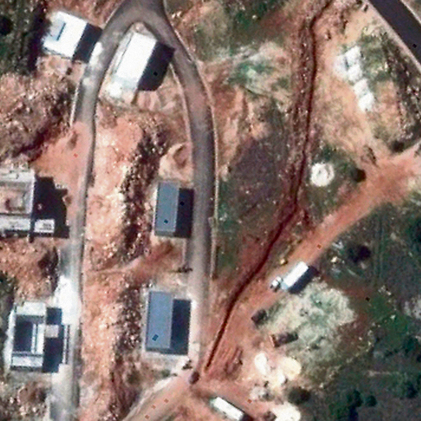
“Every country has vital assets it seeks to protect,” Brig. Gen. Turgeman says. “Energy sources, gas reservoirs, weapon manufacturing facilities, population centers. Fifty meters can make a major difference between insignificant damage and the ability to put them out of commission and harm the state and its defense establishment from a functional aspect. If I’m capable of launching 100,000 missiles into Lebanon, but can put the entire state out of commission with 20 missiles—that’s where the difference lies.”
The “war between wars” orchestrated by Brig. Gen. Turgeman is a very complicated system, which involves non-military security organizations like the Mossad, for example. “There are dozens of sub-systems operating according to logic rather than on a geographical base,” he explains. “There’s a Hamas axis and we’re try to deal with the entire chain, so it’s not a geographical issue—it’s a topical issue.
“The ‘war between wars’ has to do with partnerships, interests shared by several elements. They want peace and quiet in their region, and so do we. The Russians, for example. We’re not their partners and we don’t coordinate with them, but there’s a system aimed at preventing friction. We’re doing everything in our power to prevent the friction. We both want peace and quiet, but our interests are different. They want to strengthen their presence in Syria, and were refusing to let Iran enter Syria.”
Where’s the Iranian involvement?
“Iran is investing hundreds of millions in funds and in war materials in Syria and in Lebanon. It’s the source of the axis of evil today. It supports our entire first circle of enemies—Hamas, the Islamic Jihad, Hezbollah and Syria. Iran is doing everything in its power to strengthen its presence in Syria as its front post. It’s not even a post; we’re talking about a much more significant base, with planes that are deployed there. We’ll do everything to prevent this from happening. It’s clear to us that (Syrian President Bashar) Assad’s weakness and Iran’s infiltration into Syria pose a very big threat to the State of Israel. Iran has one goal—to wipe the State of Israel off the face of the earth. They have been declaring it everywhere—in their discussions, in the media—and it’s the only thing they’re not lying about.”
Communication also plays a role in the “war between wars,” Turgeman says. “Today, the ‘war between wars’ involves strategic communication. We ask the chief of staff who we want to convey messages to and what do we want to convey. We can tell the Americans, for example, that we’re about to carry out an operation.”
You don’t tell the Russians?
“When a plane deviates from its flight path or when we see spillover fire, we inform them we’re not going to ignore it. At the end of the day, they’re pretty much the landlords in Syria. The Russian tool can be an enemy, as far as our forces are concerned, but we don’t see it that way. We do everything in our power to clarify things and to avoid creating friction with the Russians in the ‘war between wars’ activities. We take into account that the Russians’ advanced tools aren’t operated by Assad, but rather with Russian authority. Moreover, we have an intelligence advantage, and when we detected a concrete warning of an attack against Russian forces, we informed them about it and prevented the attack. They were very grateful.”
Despite the recent terror attack in Har Adar, in which three Israeli security guards were murdered by a Palestinian, Turgeman clarifies that there is a drop in the number of attacks.
“This year’s figures are lower than last year’s,” he says. “I always compare to the previous year. The High Holy Days are an event. It begins with Eid al-Adha, the olive picking and all the disturbances of burning and uprooting trees. It’s a period in which Israelis travel across the country, so there are more opportunities to throw stones at them. Last year we had a wave of attacks. This year we are facing more complicated strategic constraints. The coordination with the Palestinian Authority is lacking, limited, completely different from our experience before the Temple Mount attack.”
According to Turgeman, “The chief of staff is insisting, rightfully, on not returning to the days before the Second Lebanon War. He sees 2006 before his eyes his entire term. He keeps telling us, ‘I’m not going back there. I want a more skillful army, stronger both mentally and in every aspect of supplies and competence.”
So in case of a war, we won’t find ourselves in the same situation as in 2006, when there was not enough munition?
“No. Today, the IDF has the most accurate scope of munition in its history. Is it possible the war will take longer and we’ll need more? I don’t know, because we’re focused on a much shorter war. But the goal is not the length. The goal is to win.”










